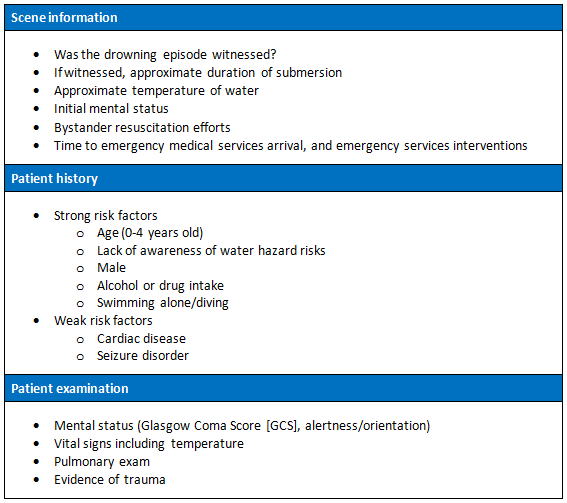Approach
While the cause of drowning is often related to swimming ability and prevailing environmental conditions, other causes (e.g., cardiac event, seizure, hypoglycaemia, trauma, overdose/intoxication, suicide/homicide) should be excluded based upon patient history and scene information.
Information from the scene, patient history, and examination can be useful in determining severity of injury, treatment plan, and prognosis.
[Figure caption and citation for the preceding image starts]: Drowning episode history and examination informationCreated by BMJ Knowledge Centre [Citation ends].
Primary examination
Hypoxaemia is the primary cause of morbidity and mortality. Apnoea or impaired oxygenation will lead to poor outcomes. Patients who are pulseless when removed from the water have a poor outcome if return of spontaneous circulation is not quickly obtained with initial ventilations.
Assessment of an unresponsive patient removed from the water should follow the standard resuscitation sequence.[36]
Hypothermia
Severe hypothermia (body temperature <30ºC) may be associated with marked depression of critical body functions such that the patient may appear dead during initial assessment. Resuscitation guidelines recommend that CPR should be continued unless the patient is unquestionably dead. Patients should not be considered dead until successful warming has been provided.[36][37][38]
Falling into icy water may trigger the mammalian diving reflex prior to the onset of hypothermia. In rare cases, especially in children, this may confer neuroprotection. Frank hypothermia is a sign of prolonged exposure and carries a poor prognosis.
Investigations
Pivotal information is obtained from the scene and the examination of the patient. Laboratory testing including pulse oximetry, blood gas evaluation, a basic metabolic panel, creatine kinase, and imaging is non-specific and primarily aids in determining drowning cause, severity and response to treatment. Laboratory testing in critically ill patients serves to elucidate precipitating events and to monitor systemic hypoxaemia, and identify end organ dysfunction. An ECG and serum cardiac biomarkers can elucidate a cardiac cause of drowning. Serum alcohol and urine drugs of misuse levels, can indicate drowning caused by intoxication or altered level of awareness associated with substance misuse. Similarly, anticonvulsant drug levels may be helpful in a person with known epilepsy.
If cervical spine injury cannot readily be excluded, a validated clinical tool such as the Pediatric Emergency Care Applied Research Network (PECARN), National Emergency X-Radiography Utilization Study (NEXUS) or the Canadian C-Spine Rule may be used to determine whether imaging is required.[39][40]
Those with suspected cervical spine injury usually exhibit obvious signs of trauma or have a witnessed event consistent with a high-risk mechanism. Patients with a witnessed drowning without a traumatic mechanism should not undergo routine spinal motion restriction.[41]
Use of this content is subject to our disclaimer